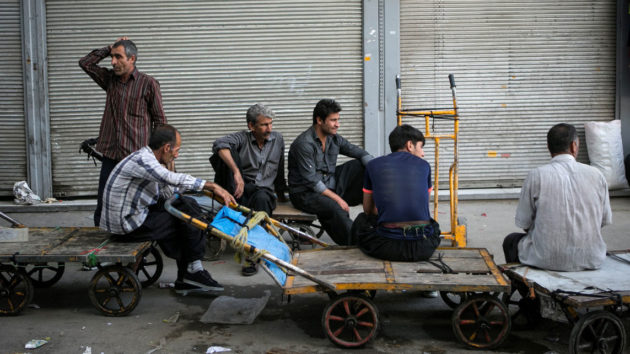Iranian Protests Underscore Regime’s Vulnerability
On Sunday, protests spontaneously erupted in Tehran, Iran’s capital, as cellphone shop owners shut down their shops and demonstrated against the plummeting value of Iran’s currency, the rial, which has devastated their businesses.
The next day they were joined by merchants in Tehran’s Grand Bazaar, a key constituency for Iran’s clerical regime. The bazaar merchants played an important role in funding the Islamist extremists led by Ayatollah Khomeini, who hijacked Iran’s broad-based 1979 revolution.
Khomeini famously downplayed the importance of economics for the revolution, which he maintained was “not about the price of watermelons.”
But Khomeini’s successors do not have the luxury of ignoring Iran’s deteriorating economic situation. They know that most Iranians of rioting age are too young to remember the 1979 revolution, but are all too familiar with the economic mismanagement, corruption, and repression that the regime imposed after the revolution.
Moreover, Iran’s current leaders lack Khomeini’s political stature, religious credentials, charisma, and popular legitimacy.
The demonstrations earlier this week, which eased after three days, are the latest manifestations of a long-simmering popular backlash against the economic policies and misplaced priorities of Iran’s Islamist regime.
President Donald Trump’s May 8 announcement that the United States will re-impose sanctions on Iran after withdrawing from the 2015 nuclear agreement made Iran’s economic situation even worse. This accelerated the fall in value of Iran’s currency and spurred capital flight.
The protests have severely undermined President Hassan Rouhani, who denounced the United States for launching an “economic war” against Iran and vowed to thwart U.S. efforts to “defeat our nation.” But many of the protesters see the problem as originating with their own government, chanting: “Our enemy is here! It is a lie that America is our enemy!”
They also directed their ire at Ayatollah Ali Khamenei, Khomeini’s successor as Iran’s supreme leader, whose power and authority greatly outweighs that of the president under Iran’s Islamist constitution. On Wednesday, Khamenei called on Iran’s judiciary to punish “those who disrupt economic security.”
Economic Hardship Breeds Political Instability
Since late December 2017, Iran has been wracked by widespread popular protests over falling living standards, economic mismanagement, corruption, repression, and expensive foreign interventions that have diverted scarce state resources from domestic economic projects.
By early January 2018, the protests mushroomed to include more than 75 cities and towns, despite a crackdown by security forces that killed at least 25 protesters and jailed almost 5,000. These were the biggest demonstrations since the 2009 nationwide protests against the fraudulent re-election of former President Mahmoud Ahmadinejad.
Significantly, while the 2009 protests were led by urban middle-class and professional elites that have long chafed under Islamist rule, the most recent wave of protests have included working-class and poor Iranians from provinces and rural areas that formerly were considered bastions of support for the regime. Although nationwide protests subsided, protests over local causes, ethnic grievances, and religious discrimination, as well as labor strikes, have erupted sporadically.
The United States should publicize, promote, and support the legitimate political, civil, and economic grievances of Iranians and foster their efforts to recover freedom from the totalitarian Islamist dictatorship.
Washington cannot orchestrate regime change in Iran, but it can help create an environment where change is possible. Ultimately, it is the Iranian people who will hold the regime accountable for its crimes.
The United States can assist by undermining the power of the ayatollahs through sanctions and by driving up the long-term costs of the regime’s malign policies.
The regime must be convinced that if it continues on its present course, then it risks not only a domestic backlash against the skyrocketing price of melons, but also its own survival.
COMMENTARY BY
James Phillips
James Phillips is the senior research fellow for Middle Eastern affairs at the Douglas and Sarah Allison Center for Foreign Policy Studies at The Heritage Foundation. He has written extensively on Middle Eastern issues and international terrorism since 1978. Read his research.
RELATED ARTICLES:
How the U.S. Can—and Should—Promote Freedom in Iran
What the US Should Do as Protests Escalate in Iran Against the Islamist Regime
More International Pressure Needed to Advance Freedom in Iran
Obama Administration Must Speak Out Against Iran’s Clenched Fist
Dear Readers:
With the recent conservative victories related to tax cuts, the Supreme Court, and other major issues, it is easy to become complacent.
However, the liberal Left is not backing down. They are rallying supporters to advance their agenda, moving this nation further from the vision of our founding fathers.
If we are to continue to bring this nation back to our founding principles of limited government and fiscal conservatism, we need to come together as a group of likeminded conservatives.
This is the mission of The Heritage Foundation. We want to continue to develop and present conservative solutions to the nation’s toughest problems. And we cannot do this alone.
We are looking for a select few conservatives to become a Heritage Foundation member. With your membership, you’ll qualify for all associated benefits and you’ll help keep our nation great for future generations.
ACTIVATE YOUR MEMBERSHIP TODAY
EDITORS NOTE: The featured image is of Workers sitting in font of closed shops at old main bazaar in downtown Tehran, Iran. (Photo: Xinhua/Sipa USA/Newscom)




Leave a Reply
Want to join the discussion?Feel free to contribute!